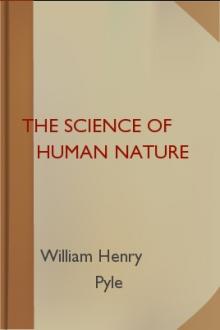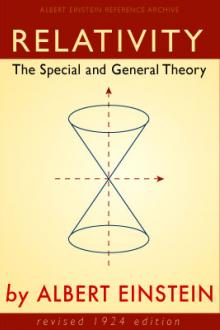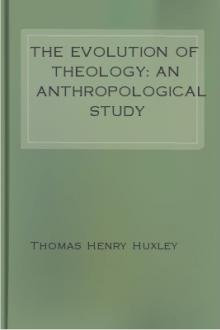Time and Tide, Sir Robert Stawell Ball [the alpha prince and his bride full story free txt] 📗

- Author: Sir Robert Stawell Ball
Book online «Time and Tide, Sir Robert Stawell Ball [the alpha prince and his bride full story free txt] 📗». Author Sir Robert Stawell Ball
work that is done--whether by any machine or contrivance, by the muscles of man or any other animal, by the winds, the waves, or the tides, or in any other way whatever--a certain equivalent quantity of energy must have been expended. When, therefore, we see any work being performed, we may always look for the source of energy to which the machine owes its efficiency. In fact, it is the old story illustrated, that perpetual motion is impossible. A mechanical device, however ingenious may be the construction, or however accurate the workmanship, can never possess what is called perpetual motion. It is needless to enter into details of any proposed contrivance of wheels, of pumps, of pulleys; it is sufficient to say that nothing in the shape of mechanism can work without friction, that friction produces heat, that heat is a form of energy, and that to replace the energy consumed in producing the heat there must be some source from which the machine is replenished if its motion is to be continued indefinitely.
Hence, as the tides may be regarded as a machine doing work, we have to ascertain the origin of that energy which they are continually expending. It is at this point that we first begin to feel the difficulties inherent in the theory of tidal evolution. I do not mean difficulties in the sense of doubts, for up to the present I have mentioned no doubtful point. When I come to such I shall give due warning. By difficulties I now mean points which it is not easy to understand without a little dynamical theory; but we must face these difficulties, and endeavour to elucidate them as well as we can.
Let us first see what the sources of energy can possibly be on which the tides are permitted to draw. Our course is simplified by the fact that the energy of which we have to speak is of a mechanical description, that is to say, not involving heat or other more obscure forms of energy. A simple type of energy is that possessed by a clock-weight after the clock has been wound. A store of power is thus laid up which is gradually doled out during the week in small quantities, second by second, to sustain the motion of the pendulum. The energy in this case is due to the fact that the weight is attracted by the earth, and is yielded according as the weight sinks downwards. In the separation between two mutually attracting bodies, a store of energy is thus implied. What we learn from an ordinary clock may be extended to the great bodies of the universe. The moon is a gigantic globe separated from our earth by a distance of 240,000 miles. The attraction between these two bodies always tends to bring them together. No doubt the moon is not falling towards the earth as the descending clock-weight is doing. We may, in fact, consider the moon, so far as our present object is concerned, to be revolving almost in a circle, of which the earth is the centre. If the moon, however, were to be stopped, it would at once commence to rush down towards the earth, whither it would arrive with an awful crash in the course of four or five days. It is fortunately true that the moon does not behave thus; but it has the ability of doing so, and thus the mere separation between the earth and the moon involves the existence of a stupendous quantity of energy, capable under certain conditions of undergoing transformation.
There is also another source of mechanical energy besides that we have just referred to. A rapidly moving body possesses, in virtue of its motion, a store of readily available energy, and it is easy to show that energy of this type is capable of transformation into other types. Think of a cannon-ball rushing through the air at a speed of a thousand feet per second; it is capable of wreaking disaster on anything which it meets, simply because its rapid motion is the vehicle by which the energy of the gunpowder is transferred from the gun to where the blow is to be struck. Had the cannon been directed vertically upwards, then the projectile, leaving the muzzle with the same initial velocity as before, would soar up and up, with gradually abating speed, until at last it reached a turning-point, the elevation of which would depend upon the initial velocity. Poised for a moment at the summit, the cannon-ball may then be likened to the clock-weight, for the entire energy which it possessed by its motion has been transformed into the statical energy of a raised weight. Thus we see these two forms of energy are mutually interchangeable. The raised weight if allowed to fall will acquire velocity, or the rapidly moving weight if directed upwards will acquire altitude.
The quantity of energy which can be conveyed by a rapidly moving body increases greatly with its speed. For instance, if the speed of the body be doubled, the energy will be increased fourfold, or, in general, the energy which a moving body possesses may be said to be proportional to the square of its speed. Here then we have another source of the energy present in our earth-moon system; for the moon is hurrying along in its path with a speed of two-thirds of a mile per second, or about twice or three times the speed of a cannon-shot. Hence the fact that the moon is continuously revolving in a circle shows us that it possesses a store of energy which is nine times as great as that which a cannon-ball as massive as the moon, and fired with the ordinary velocity, would receive from the powder which discharged it.
Thus we see that the moon is endowed with two sources of energy, one of which is due to its separation from the earth, and the other to the speed of its motion. Though these are distinct, they are connected together by a link which it is important for us to comprehend. The speed with which the moon revolves around the earth is connected with the moon's distance from the earth. The moon might, for instance, revolve in a larger circle than that which it actually pursues; but if it did so, the speed of its motion would have to be appropriately lessened. The orbit of the moon might have a much smaller radius than it has at present, provided that the speed was sufficiently increased to compensate for the increased attraction which the earth would exercise at the lessened distance. Indeed, I am here only stating what every one is familiar with under the form of Kepler's Law, that the square of the periodic time is in proportion to the cube of the mean distance. To each distance of the moon therefore belongs an appropriate speed. The energy due to the moon's position and the energy due to its motion are therefore connected together. One of these quantities cannot be altered without the other undergoing change. If the moon's orbit were increased there would be a gain of energy due to the enlarged distance, and a loss of energy due to the diminished speed. These would not, however, exactly compensate. On the whole, we may represent the total energy of the moon as a single quantity, which increases when the distance of the moon from the earth increases, and lessens when the distance from the earth to the moon lessens. For simplicity we may speak of this as moon-energy.
But the most important constituent of the store of energy in the earth-moon system is that contributed by the earth itself. I do not now speak of the energy due to the velocity of the earth in its orbit round the sun. The moon indeed participates in this equally with the earth, but it does not affect those mutual actions between the earth and moon with which we are at present concerned. We are, in fact, discussing the action of that piece of machinery the earth-moon system; and its action is not affected by the circumstance that the entire machine is being bodily transported around the sun in a great annual voyage. This has little more to do with the action of our present argument than has the fact that a man is walking about to do with the motions of the works of the watch in his pocket. We shall, however, have to allude to this subject further on.
The energy of the earth which is significant in the earth-moon theory is due to the earth's rotation upon its axis. We may here again use as an illustration the action of machinery; and the special contrivance that I now refer to is the punching-engine that is used in our ship-building works. In preparing a plate of iron to be riveted to the side of a ship, a number of holes have to be made all round the margin of the plate. These holes must be half an inch or more in diameter, and the plate is sometimes as much as, or more than, half an inch in thickness. The holes are produced in the metal by forcing a steel punch through it; and this is accomplished without even heating the plate so as to soften the iron. It is needless to say that an intense force must be applied to the punch. On the other hand, the distance through which the punch has to be moved is comparatively small. The punch is attached to the end of a powerful lever, the other end of the lever is raised by a cam, so as to depress the punch to do its work. An essential part of the machine is a small but heavy fly-wheel connected by gearing with the cam.
This fly-wheel when rapidly revolving contains within it, in virtue of its motion, a large store of energy which has gradually accumulated during the time that the punch is not actually in action. The energy is no doubt originally supplied from a steam-engine. What we are especially concerned with is the action of the rapidly rotating wheel as a reservoir in which a large store of energy can be conveniently maintained until such time as it is wanted. In the action of punching, when the steel die comes down upon the surface of the plate, a large quantity of energy is suddenly demanded to force the punch against the intense resistance it experiences; the energy for this purpose is drawn from the store in the fly-wheel, which experiences no doubt a check in its velocity, to be regained again from the energy of the engine during the interval which elapses before the punch is called on to make the next hole.
Another illustration of the fly-wheel on a splendid scale is seen in our mighty steel works, where ponderous rails are being manufactured. A white-hot ingot of steel is presented to a pair of powerful rollers, which grip the steel, and send it through at the other side both compressed and elongated. Tremendous power is required to meet the sudden demand on the machine at the critical moment. To obtain this power an engine of stupendous proportions is sometimes attached directly to the rollers, but more frequently an engine of rather less horse-power will be used, the might of this engine being applied to giving rapid rotation to an immense fly-wheel, which may thus be regarded as a reservoir full of energy. The rolling mills then obtain from this store in the fly-wheel whatever energy is necessary for their gigantic task.
These illustrations will suffice to show how a rapidly rotating body may contain energy in virtue of its rotation, just as a cannon-ball contains energy in virtue of its speed of translation, or as a clock-weight has energy in
Hence, as the tides may be regarded as a machine doing work, we have to ascertain the origin of that energy which they are continually expending. It is at this point that we first begin to feel the difficulties inherent in the theory of tidal evolution. I do not mean difficulties in the sense of doubts, for up to the present I have mentioned no doubtful point. When I come to such I shall give due warning. By difficulties I now mean points which it is not easy to understand without a little dynamical theory; but we must face these difficulties, and endeavour to elucidate them as well as we can.
Let us first see what the sources of energy can possibly be on which the tides are permitted to draw. Our course is simplified by the fact that the energy of which we have to speak is of a mechanical description, that is to say, not involving heat or other more obscure forms of energy. A simple type of energy is that possessed by a clock-weight after the clock has been wound. A store of power is thus laid up which is gradually doled out during the week in small quantities, second by second, to sustain the motion of the pendulum. The energy in this case is due to the fact that the weight is attracted by the earth, and is yielded according as the weight sinks downwards. In the separation between two mutually attracting bodies, a store of energy is thus implied. What we learn from an ordinary clock may be extended to the great bodies of the universe. The moon is a gigantic globe separated from our earth by a distance of 240,000 miles. The attraction between these two bodies always tends to bring them together. No doubt the moon is not falling towards the earth as the descending clock-weight is doing. We may, in fact, consider the moon, so far as our present object is concerned, to be revolving almost in a circle, of which the earth is the centre. If the moon, however, were to be stopped, it would at once commence to rush down towards the earth, whither it would arrive with an awful crash in the course of four or five days. It is fortunately true that the moon does not behave thus; but it has the ability of doing so, and thus the mere separation between the earth and the moon involves the existence of a stupendous quantity of energy, capable under certain conditions of undergoing transformation.
There is also another source of mechanical energy besides that we have just referred to. A rapidly moving body possesses, in virtue of its motion, a store of readily available energy, and it is easy to show that energy of this type is capable of transformation into other types. Think of a cannon-ball rushing through the air at a speed of a thousand feet per second; it is capable of wreaking disaster on anything which it meets, simply because its rapid motion is the vehicle by which the energy of the gunpowder is transferred from the gun to where the blow is to be struck. Had the cannon been directed vertically upwards, then the projectile, leaving the muzzle with the same initial velocity as before, would soar up and up, with gradually abating speed, until at last it reached a turning-point, the elevation of which would depend upon the initial velocity. Poised for a moment at the summit, the cannon-ball may then be likened to the clock-weight, for the entire energy which it possessed by its motion has been transformed into the statical energy of a raised weight. Thus we see these two forms of energy are mutually interchangeable. The raised weight if allowed to fall will acquire velocity, or the rapidly moving weight if directed upwards will acquire altitude.
The quantity of energy which can be conveyed by a rapidly moving body increases greatly with its speed. For instance, if the speed of the body be doubled, the energy will be increased fourfold, or, in general, the energy which a moving body possesses may be said to be proportional to the square of its speed. Here then we have another source of the energy present in our earth-moon system; for the moon is hurrying along in its path with a speed of two-thirds of a mile per second, or about twice or three times the speed of a cannon-shot. Hence the fact that the moon is continuously revolving in a circle shows us that it possesses a store of energy which is nine times as great as that which a cannon-ball as massive as the moon, and fired with the ordinary velocity, would receive from the powder which discharged it.
Thus we see that the moon is endowed with two sources of energy, one of which is due to its separation from the earth, and the other to the speed of its motion. Though these are distinct, they are connected together by a link which it is important for us to comprehend. The speed with which the moon revolves around the earth is connected with the moon's distance from the earth. The moon might, for instance, revolve in a larger circle than that which it actually pursues; but if it did so, the speed of its motion would have to be appropriately lessened. The orbit of the moon might have a much smaller radius than it has at present, provided that the speed was sufficiently increased to compensate for the increased attraction which the earth would exercise at the lessened distance. Indeed, I am here only stating what every one is familiar with under the form of Kepler's Law, that the square of the periodic time is in proportion to the cube of the mean distance. To each distance of the moon therefore belongs an appropriate speed. The energy due to the moon's position and the energy due to its motion are therefore connected together. One of these quantities cannot be altered without the other undergoing change. If the moon's orbit were increased there would be a gain of energy due to the enlarged distance, and a loss of energy due to the diminished speed. These would not, however, exactly compensate. On the whole, we may represent the total energy of the moon as a single quantity, which increases when the distance of the moon from the earth increases, and lessens when the distance from the earth to the moon lessens. For simplicity we may speak of this as moon-energy.
But the most important constituent of the store of energy in the earth-moon system is that contributed by the earth itself. I do not now speak of the energy due to the velocity of the earth in its orbit round the sun. The moon indeed participates in this equally with the earth, but it does not affect those mutual actions between the earth and moon with which we are at present concerned. We are, in fact, discussing the action of that piece of machinery the earth-moon system; and its action is not affected by the circumstance that the entire machine is being bodily transported around the sun in a great annual voyage. This has little more to do with the action of our present argument than has the fact that a man is walking about to do with the motions of the works of the watch in his pocket. We shall, however, have to allude to this subject further on.
The energy of the earth which is significant in the earth-moon theory is due to the earth's rotation upon its axis. We may here again use as an illustration the action of machinery; and the special contrivance that I now refer to is the punching-engine that is used in our ship-building works. In preparing a plate of iron to be riveted to the side of a ship, a number of holes have to be made all round the margin of the plate. These holes must be half an inch or more in diameter, and the plate is sometimes as much as, or more than, half an inch in thickness. The holes are produced in the metal by forcing a steel punch through it; and this is accomplished without even heating the plate so as to soften the iron. It is needless to say that an intense force must be applied to the punch. On the other hand, the distance through which the punch has to be moved is comparatively small. The punch is attached to the end of a powerful lever, the other end of the lever is raised by a cam, so as to depress the punch to do its work. An essential part of the machine is a small but heavy fly-wheel connected by gearing with the cam.
This fly-wheel when rapidly revolving contains within it, in virtue of its motion, a large store of energy which has gradually accumulated during the time that the punch is not actually in action. The energy is no doubt originally supplied from a steam-engine. What we are especially concerned with is the action of the rapidly rotating wheel as a reservoir in which a large store of energy can be conveniently maintained until such time as it is wanted. In the action of punching, when the steel die comes down upon the surface of the plate, a large quantity of energy is suddenly demanded to force the punch against the intense resistance it experiences; the energy for this purpose is drawn from the store in the fly-wheel, which experiences no doubt a check in its velocity, to be regained again from the energy of the engine during the interval which elapses before the punch is called on to make the next hole.
Another illustration of the fly-wheel on a splendid scale is seen in our mighty steel works, where ponderous rails are being manufactured. A white-hot ingot of steel is presented to a pair of powerful rollers, which grip the steel, and send it through at the other side both compressed and elongated. Tremendous power is required to meet the sudden demand on the machine at the critical moment. To obtain this power an engine of stupendous proportions is sometimes attached directly to the rollers, but more frequently an engine of rather less horse-power will be used, the might of this engine being applied to giving rapid rotation to an immense fly-wheel, which may thus be regarded as a reservoir full of energy. The rolling mills then obtain from this store in the fly-wheel whatever energy is necessary for their gigantic task.
These illustrations will suffice to show how a rapidly rotating body may contain energy in virtue of its rotation, just as a cannon-ball contains energy in virtue of its speed of translation, or as a clock-weight has energy in
Free e-book «Time and Tide, Sir Robert Stawell Ball [the alpha prince and his bride full story free txt] 📗» - read online now
Similar e-books:





Comments (0)